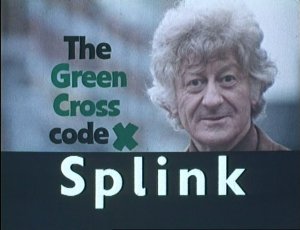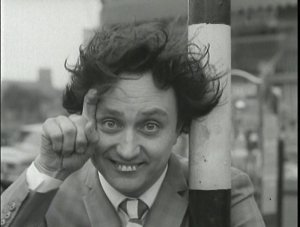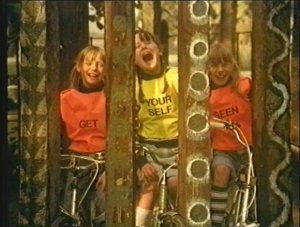The Good Old Days? - Road Safety (part 2; Tell It to the Kids)
The first article in this series looked at road safety PIFs aimed at motorists. Of course, any road safety campaigner worth their salt knows that you can't just address one group of users and hope for the best. It takes two to make an accident, so in this concluding article on road safety PIFs, we take a look at the PIFs aimed at cyclists and pedestrians, primarily children.
Crossing the Road - Keep Death Off the Road/Road Safety - Pedestrians No.1
'Keep Death Off the Road' is an interesting 1946 MOI early road safety PIF, referring to the public not long ago having to protect themselves from danger overhead, but now having to protect themselves from danger on the ground, i.e. vehicles. It also makes the reasonable point that it takes two to make an accident, as no doubt motorists and pedestrians were blaming each other for causing accidents in the early days of driving. Nowadays, the responsibility very much lies with the driver. The PIF quotes figures of 63,000 pedestrians killed and injured a year, with 42,000 accidents caused by stepping carelessly into the road. The Department of Transport cites that today, with more than 27 million vehicles in Britain, the number of people killed or seriously injured on the roads stands at something under 32,000 a year, with around 3,000 killed. BBC Online also mentions that back in 1931 that more than 7,000 were killed on the roads - yet there were just 2.3 million vehicles around. Damn nanny state!
Pedestrian Crossing/Don't Abuse the Crossing/The Highway Code - Pedestrian Crossings/The Highway Code - Mr. Gamp/Road Safety Pedestrians No.2 - Older People (40s, 50s and 60s)
It's extraordinary to think that, back in the 40s and 50s, there were an awful lot of people who hadn't grown up with traffic as a concern. These PIFs were aimed at older people, who had grown up in the Edwardian era, and who evidently were baffled by pedestrian crossings; often to their severe cost.
 |
Splink/Crossing the Road - Explorers/Tufty Club/Road Safety (50s-70s)
In 'Splink', Jon Pertwee and Derek Griffiths deliver a hilariously badly thought-out road safety message. Interestingly, this campaign was in 1976, just after the long-lasting and successful "Stop, Look, Listen", so why civil servants felt the need to over-complicate matters is anyone's guess. For the record, here's SPLINK in all its glory;
S - Find a safe place to cross, then stop.
P - Stand on the pavement, near the kerb.
L - Look all around for traffic and listen.
I - If traffic is coming, let it pass.
N - When there is no traffic near, walk straight across the road.
K - Keep looking and listening for traffic while you cross.
UK readers may recognise that the same message was delivered far more effectively using "Stop, Look and Listen". Even Jon Pertwee couldn't save this wet fart of a campaign. "SPLINK helps you to remember the Green Cross Code"; NO IT DOESN'T. I had to replay the PIF a couple of times just to copy the damn thing down. By the way, I know the eldest boy in the PIF is Todd Carty; but is the youngest kid Dexter Fletcher?
One Minute/How Well Have You Trained Your Child?/Road Safety - Pedestrians No 2 - Look and Listen/Crossing the Road - Explorers (40s-70s)
Road safety has of course become even more important over the years, but the one thing that really jumps out at you in these PIFs is the assumption that over 5s WILL be out on their own, which is something which would not be assumed today. Sadly, public hysteria over the subject of child abduction and abuse has meant that many parents don't let their kids out to play alone, and road safety has actually become a secondary concern, despite the fact that children are far more likely to be involved in an accident with a car than be abducted (the rate of abductions has remained the same for 30 years). It also seems that parents 30 years ago seemed to underestimate the danger traffic posed to children, rather than the overestimation that happens today.
Cycling Proficiency Test (50s/60s)
A PIF to launch this then-new test for cyclists, explaining that if you're going to let your youngster out on the roads on a cycle, they should know the skills this test teaches. This test is not mandatory, but is still used today to promote cyclist safety. I failed mine at primary school because it was raining. Not because I was rubbish.
 |
Pedestrian Crossing - Ken Dodd (1963)
Ken Dodd plays several characters in this sequence around a pedestrian crossing, (which appears to have been filmed in Northfields Avenue, Ealing, the one-time home of two NTS writers) all telling each other merrily how they should behave. Ken then looks into the camera and says "But seriously, folks, everyone should use the crossings properly." Then he does that funny thing with his teeth, which I presume was popular at the time.
Green Cross Code (1975/1976/1983)
Perhaps the most famous children's road safety campaign ever, using the striking phrase 'Stop, Look, Listen', which is far more memorable than 'Splink'. The COI got 'children's heroes' of the time, such as Kevin Keegan, Joe Bugner and, erm, Alvin Stardust, to accost children who were stepping out into the road with little care, and teaching them to 'Stop, Look and Listen'. The Green Cross Code man was also created, both in animated form and in the form of Dave Prowse, to give children a road safety superhero. Sounds corny, but I didn't have a Green Cross Code gym bag at primary school for nothing. Trends of the time were reflected in these films; one has a R2D2 robot to teach the message, and there's an ingenious one from 1983 which uses 'The Message' by Grandmaster Flash. "Don't step out/'cause you're close to the edge/Stop, look, listen, think/and you won't lose your head". The YouTube link shows a different edit to the one on the Charley DVD. The Green Cross Code is still being used today, with the use of some rather cute hedgehogs, and up-to-date advice, such as telling children to take out their earphones when crossing the road.
Under 5s - How to Cross the Roads (1973)
Tufty, a character devised in the 50s to teach children about road safety, was used in these beautifully made PIFs to convey the consequences of various behaviours to very young children. Several of these are on the DVD (including a Welsh variant), and concentrate mainly on not running into the road. Tufty tends to be the well-behaved boy, with Willy Weasel doing the silly things and being knocked down for his trouble. The moment of impact between Willy and the car is tastefully out of shot. Bernard Cribbins does the voiceover for the English PIFs, which may be responsible for me wanting to suck my thumb every time I hear his voice.
Pelican Motorist/Pelican Pedestrians (1969)/Pelican Crossing Song (1976)/Pelican Crossing - Dad's Army (1974)
These PIFs explain how the newly launched Pelican crossings work from the pedestrian and motorist perspective. These crossings have been a great success all over the UK, and it isn't until Brits go abroad that they realise just what a good invention they were. The cast of Dad's Army turned up in 1974 to reinforce the message ('Learn Your Blinking Pelican Signals'), with the Pelican Crossing Song providing an entertaining alternative. If you look closely, you'll see the car driver being played by Charlie Slater 'off of' Eastenders in Pelican Crossing Song.
 |
Pedal Safety Song (1978)
Ah, nothing like a catchy song to get your message across. The lyrics tell cyclists to make sure they are clearly visible on the roads, with plenty of people putting the recommendations into practise. "Make it big/make it bold/make it right/and get yourself seen". Again, not something that's always observed. As a motorist myself, I can tell you that cyclists without lights and in dark clothing are very difficult to see. 'White at Night' and 'Wear Something Light' give the same message.
Children Watch Us Cross (1972?)
The YouTube user who uploaded this accuses it of being the most annoying road safety public information film of all time, but I think this is rather unfair. The little boy describing the hypocritical behaviour of his parents is quite amusing, even if he mucks up the emphasis a few times, and the point is fairly made. As with most things in life, if you tell your child one thing, and they see you do the other, it won't be your words they remember.
Road Test Pedestrians (1974)
A clever little PIF with Frank Thornton assessing the roadworthiness of the average human (Larry Martyn). We don't measure up well; so we need to take care.
Zig-Zag Pedestrians (1979)
Willie Rushden lends his mellifluous tones on this animated PIF with zig-zags on pedestrian crossings snapping at people foolish enough not to 'keep out of the zig-zag zone'. For foreign readers, zig-zags mark the areas where cars can wait; therefore, drivers will be less likely to be on the look-out for pedestrians crossing there.
Two Wheel Riders - Look Back (70s/80s)
A rather delightful PIF with a classical soundtrack, advising riders to 'look back' before every manoeuvre. Sound advice.
Children Overtake (1981)
An animated PIF voiced by Kenny Everett, 'Children Overtake' features Augustus Windsock demonstrating how to overtake a parked vehicle whilst cycling.
Road safety is something we're taught from the cradle nowadays in the UK, and it's a common bugbear of British tourists that many countries just don't seem to have the same concern that we do on the relationship between vehicles and other road users. However, it's a reasonable concern, as the website Expatica quotes Britain as having one of the lowest casualty rates in the EU, and suggests that low casualty rates are a result of governments taking the problem seriously. Seeing as road safety, at its most basic level, is achieved through all road users respecting each other, it seems a great shame that even this basic idea can be pretty difficult for people all over the world to grasp. To those who moan about 'nannying', I would suggest that if people behaved like adults in the first place, governments wouldn't need to treat them like children.
About this entry
- By Tanya Jones
- Posted on Saturday, March 01 2008 @ 10:12 pm
- Categorised in TV, Analysis
- Tagged with PIF
- 5 comments

>which appears to have been filmed in Northfields Avenue
I'm amazed you spotted that! I'm not sure I would have done... but I think you're right, it probably is. Makes sense, being Ealing and all. Eagle eyes, though!
By Seb
March 03, 2008 @ 8:09 am
reply / #
Hey! 3 NTS writers lived there... 3!
By Rachel
March 03, 2008 @ 11:57 am
reply / #
And another lived there on weekends.
By Ian Symes
March 03, 2008 @ 1:37 pm
reply / #
Almost the entire staff of NTS slept at that fine palace at some point. Anyway, if you glance at the post office behind Dodd, you'll see the 'Northfields Avenue' address. Blame my eagle eyes and my obsession with finding out where things were filmed.
By Tanya Jones
March 03, 2008 @ 10:33 pm
reply / #
It wasn't really "slept" as such- more a shift system with people passing out just as others regained consiousness.
By Julian Hazeldine
March 04, 2008 @ 6:51 pm
reply / #